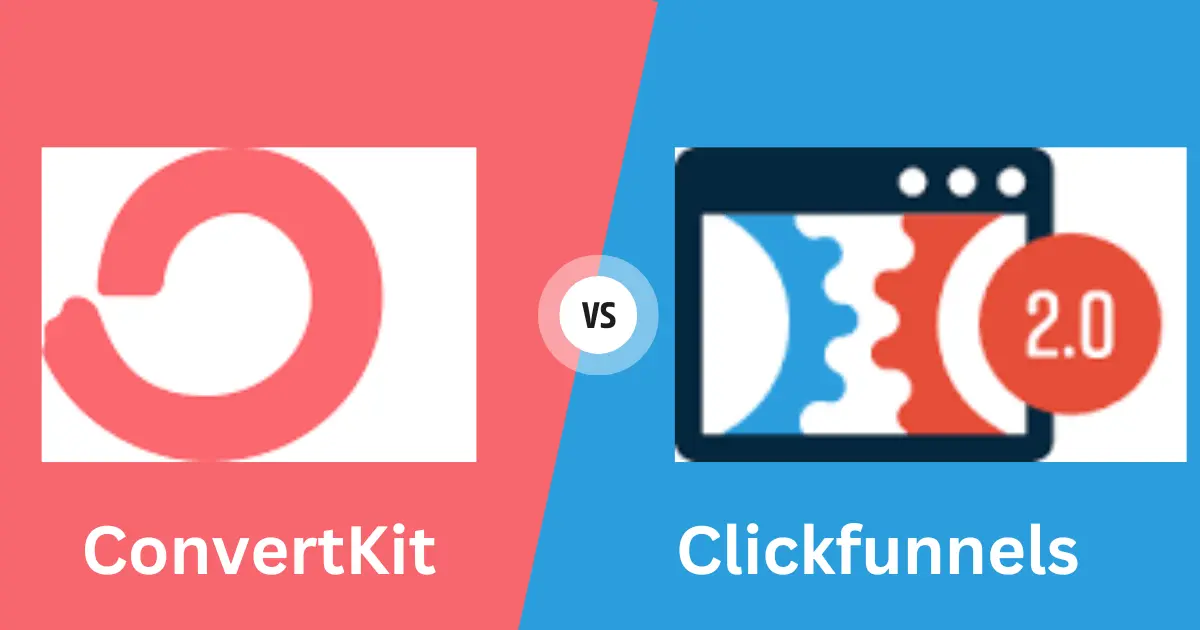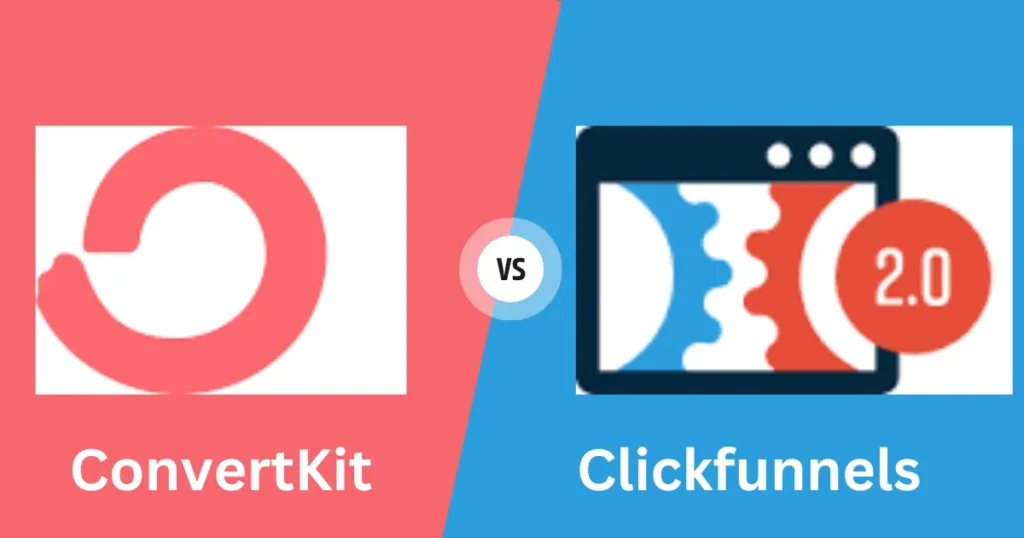
In the dynamic world of digital marketing, choosing the right tools can make all the difference in achieving your business goals. The debate of “ConvertKit vs ClickFunnels” is a hot topic among marketers, as both platforms offer unique features tailored to different aspects of online marketing. ConvertKit, renowned for its powerful email marketing capabilities, and ClickFunnels, famous for its efficient sales funnel creation, are both top contenders in the marketing software arena. But which one is the best fit for your needs?
In this comprehensive guide, we delve deep into a side-by-side comparison of ConvertKit and ClickFunnels, examining their features, usability, pricing, and much more. Whether you’re a content creator, a small business owner, or a marketing professional, this post will provide you with the insights you need to make an informed decision. Let’s explore what each platform has to offer and find out which one comes out on top in the battle of ConvertKit vs ClickFunnels.
Table of Contents
Overview of ConvertKit and ClickFunnels
When it comes to digital marketing tools, two names often emerge as leading options: ConvertKit and ClickFunnels. Understanding the key features and primary functions of each platform is crucial for marketers, entrepreneurs, and online creators. In this “ConvertKit vs ClickFunnels” comparison, we’ll provide an overview of what each tool offers, helping you decide which is best suited for your needs.
ConvertKit: Email Marketing and Audience Growth Specialist
ConvertKit, primarily known for its email marketing capabilities, is a powerful tool designed for online creators such as bloggers, podcasters, and vloggers. It excels in helping users grow their audience and nurture relationships through effective email campaigns. Key features include:
- Email automation and sequences
- Customizable opt-in forms and landing pages
- Advanced subscriber tagging and segmentation
ConvertKit’s user-friendly interface makes it easy for beginners to create professional-looking emails and manage their subscriber lists efficiently.
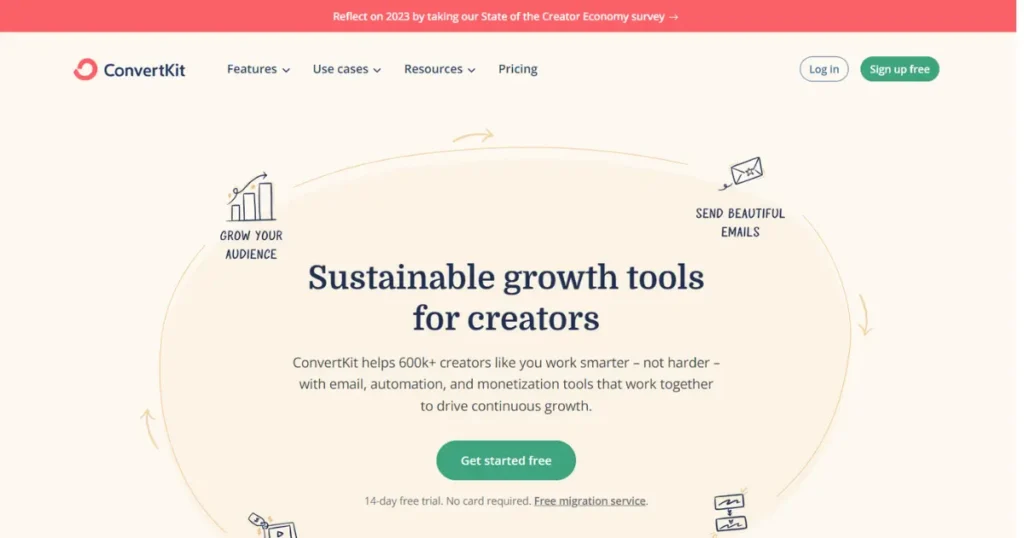
ClickFunnels: Comprehensive Sales Funnel Creation
On the other hand, ClickFunnels is tailored more towards building and optimizing sales funnels. It is a go-to tool for entrepreneurs and businesses focused on converting leads into customers. ClickFunnels offers a range of features such as:
- Drag-and-drop funnel builder
- Integrated payment processing tools
- A/B testing for landing pages
With ClickFunnels, users can create entire sales funnels, from landing pages to checkout processes, making it a robust solution for sales-driven projects.

In summary, while ConvertKit focuses on email marketing and audience engagement, ClickFunnels provides comprehensive solutions for building and optimizing sales funnels. Both platforms offer unique strengths, making the “ConvertKit vs ClickFunnels” decision dependent on your specific marketing needs and goals.
Ease of Use: ConvertKit vs ClickFunnels
When considering ConvertKit vs ClickFunnels, one of the key factors for users is the ease of use of each platform. Both tools aim to simplify digital marketing, but they do so in different ways and with varying degrees of user-friendliness.
ConvertKit is renowned for its straightforward and intuitive interface, particularly appealing to those who are new to email marketing or digital marketing in general. The platform is designed with simplicity in mind, making it easy to navigate even for beginners. Users can quickly set up email campaigns, create landing pages, and manage subscribers without feeling overwhelmed. One of the standout features of ConvertKit is its visual automation builder, which allows users to create complex email sequences with ease. It’s a drag-and-drop tool that visually represents your email flows, making it simple to understand and manage.
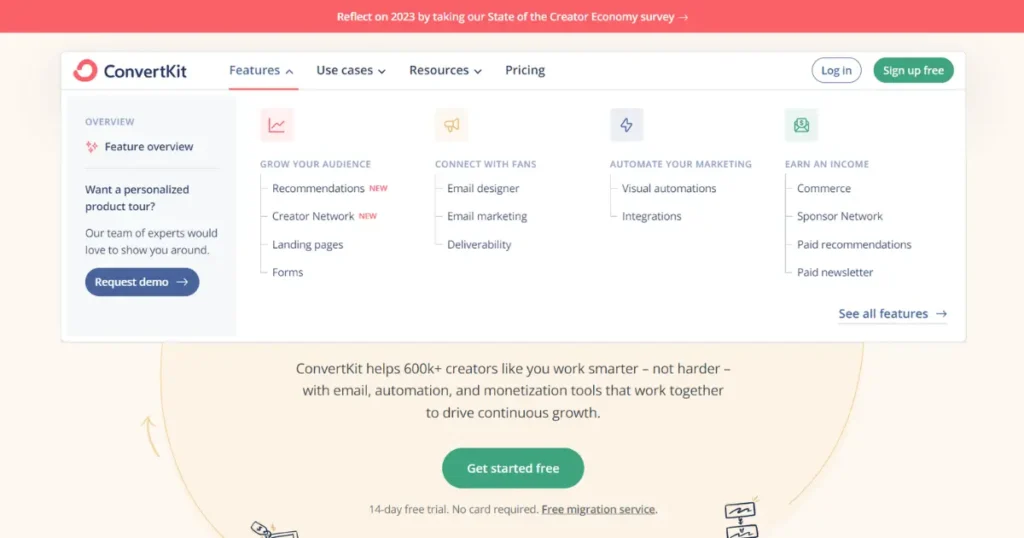
ClickFunnels, on the other hand, offers a more comprehensive set of tools for building sales funnels, which might seem daunting to some users at first. However, ClickFunnels has taken significant steps to ensure user-friendliness. The platform offers a wide range of pre-designed funnel templates, which can be customized easily using a drag-and-drop editor. This feature is particularly beneficial for users who want to create professional-looking funnels without spending too much time on design. Additionally, ClickFunnels provides extensive educational resources to help users get the most out of the platform.
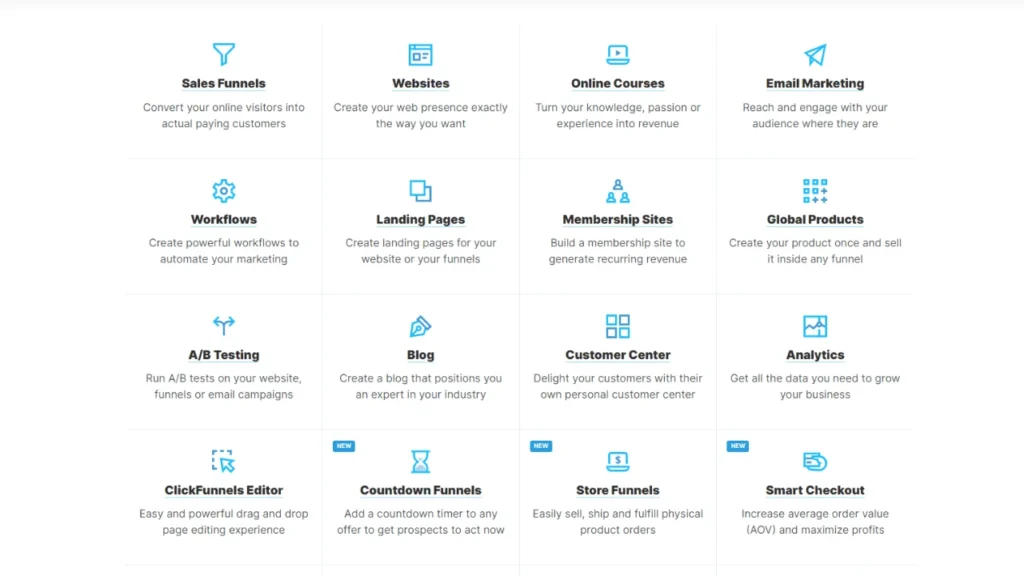
In conclusion, when it comes to ease of use in the battle of ConvertKit vs ClickFunnels, both platforms have their strengths. ConvertKit excels in creating a user-friendly experience for email marketing and automation, while ClickFunnels focuses on simplifying the sales funnel creation process with its template-based approach and educational resources. Your choice between the two will depend on your specific needs and comfort level with digital marketing tools.
Email Marketing Features: ConvertKit vs ClickFunnels
ConvertKit vs ClickFunnels
When comparing ConvertKit and ClickFunnels, especially in terms of their email marketing capabilities, it’s crucial to understand how each platform caters to the specific needs of online marketers and businesses.
ConvertKit: Email Marketing Focused
ConvertKit is primarily an email marketing tool designed for creators and online entrepreneurs. Its strengths lie in its simplicity and direct approach to email campaigns.
- Automation: ConvertKit offers a robust automation system that’s both simple and powerful. Users can easily create automated email sequences that are triggered by specific actions, such as signing up for a newsletter or purchasing a product.
- Segmentation: With ConvertKit, segmentation is straightforward and effective. You can segment your subscribers based on their interests, interactions, and other custom parameters, allowing for highly targeted email campaigns.
- Email Templates: ConvertKit keeps things minimalistic with a focus on content rather than design. Their email templates are simple, clean, and mobile-responsive, ensuring good readability across devices.
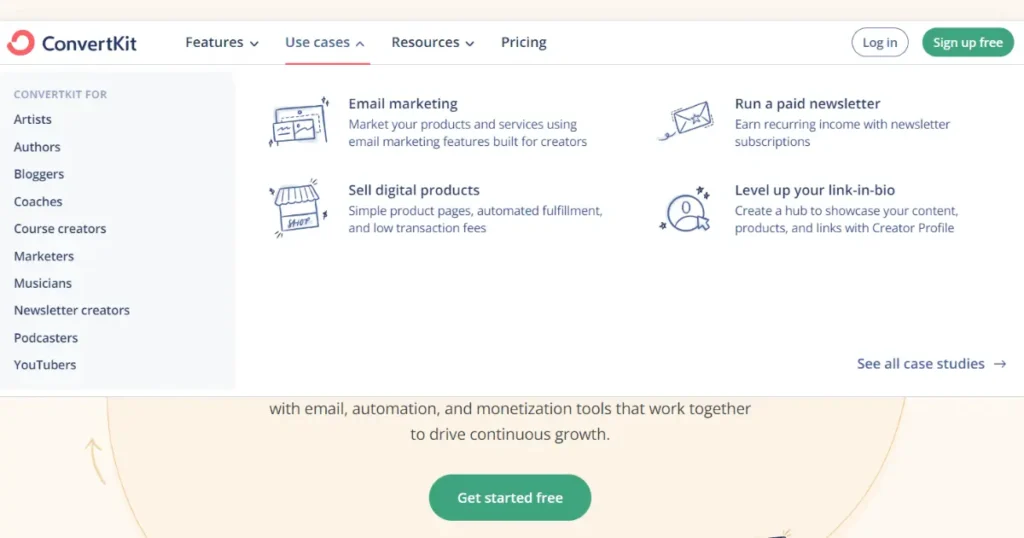
ClickFunnels: A Broader Approach
ClickFunnels, while offering email marketing features, is more focused on building sales funnels. It integrates email marketing as a part of its overall funnel-building toolkit.
- Actionetics: ClickFunnels’ email tool, Actionetics, provides a range of features including email automation, contact segmentation, and the ability to create smart lists based on customer behavior.
- Multi-Dimensional Marketing: ClickFunnels allows you to not just send emails, but to incorporate SMS, direct mail, and other channels into your marketing strategy.
- Follow-up Funnels: A unique feature of ClickFunnels, these funnels help in creating complex follow-up sequences that can be customized based on user actions and engagement levels.

Conclusion
In summary, while both ConvertKit and ClickFunnels offer email marketing features, their approaches are distinct. ConvertKit is ideal for those who need a focused and powerful email marketing tool, emphasizing content and subscriber management. ClickFunnels, on the other hand, is more suitable for businesses looking for a comprehensive marketing solution that integrates email marketing with other channels within a sales funnel context.
Remember, the choice between ConvertKit vs ClickFunnels for email marketing features depends on your specific business needs and marketing goals.
Pricing and Plans: ConvertKit vs Clickfunnels
When choosing between ConvertKit and ClickFunnels, understanding their pricing and plans is crucial for making an informed decision. Both platforms offer different pricing structures that cater to varying needs and budgets. In this section, we compare the pricing and plans of ConvertKit vs ClickFunnels to help you decide which suits your financial considerations best.
ConvertKit Pricing
ConvertKit is primarily an email marketing tool and offers a pricing structure that’s based on the number of subscribers. There are three main plans: Free, Creator, and Creator Pro.
- Free Plan: This plan is great for beginners and offers basic features such as email broadcasts, signup forms, and landing pages. However, it lacks automation features.
- Creator Plan: Starting at $29 per month for up to 1,000 subscribers, the Creator plan includes additional features like automation, integrations, and subscriber scoring. The price increases with the number of subscribers.
- Creator Pro Plan: Starting at $59 per month for up to 1,000 subscribers, this plan includes advanced features like newsletter referral system, subscriber engagement scoring, and advanced reporting. Like the Creator plan, pricing increases with more subscribers.
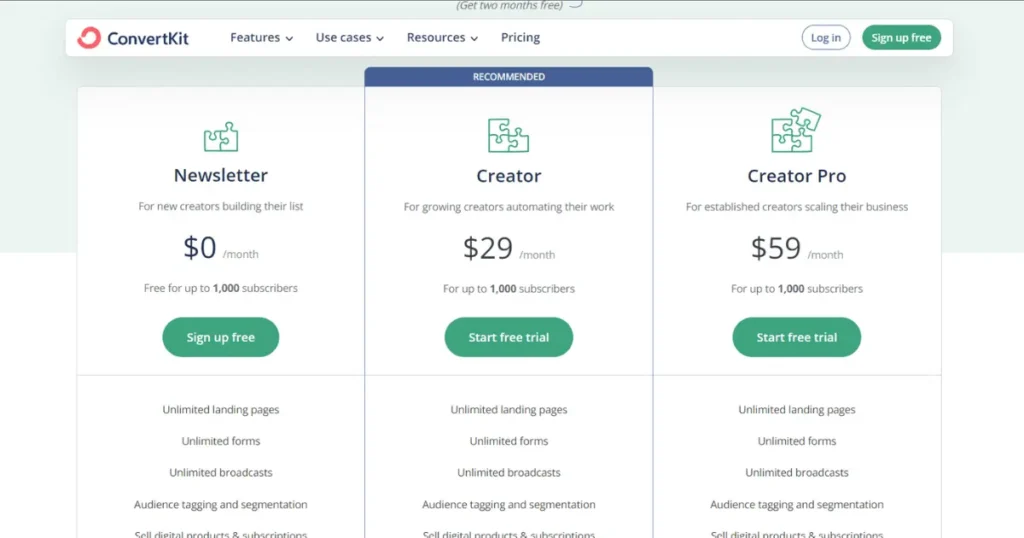
ClickFunnels Pricing
ClickFunnels, known for its sales funnel creation capabilities, offers two main pricing plans: the Standard Plan and the Platinum Plan.
- Standard Plan: Priced at $97 per month, the Standard Plan allows users to create up to 20 funnels, 100 pages, and serves up to 20,000 visitors. It includes all the basic funnel-building features but lacks advanced features like affiliate management and comprehensive analytics.
- Platinum Plan: At $297 per month, the Platinum Plan offers unlimited funnels, pages, and visitors. It includes additional features like the Backpack affiliate program, Follow-Up Funnels, and priority support.
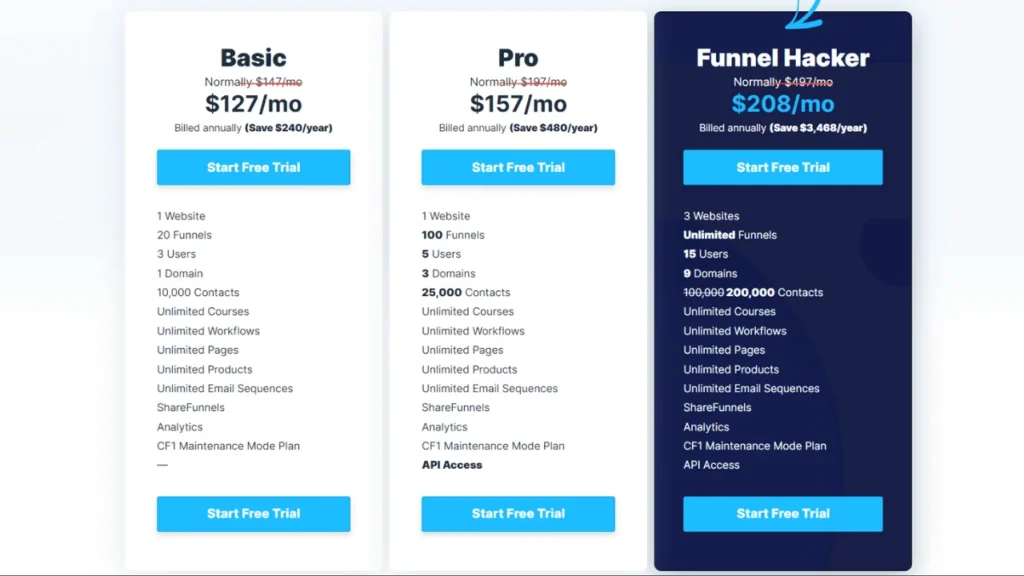
Summary
In summary, when comparing ConvertKit vs ClickFunnels in terms of pricing and plans, it’s evident that ConvertKit offers more flexibility for businesses with varying sizes of email lists, with its pricing based on the number of subscribers. ClickFunnels, on the other hand, focuses on providing comprehensive funnel-building tools and is priced based on the features and scale of usage.
Both platforms offer a range of features in their respective plans, and the right choice depends on your specific marketing needs and budget.
User Reviews and Case Studies: ConvertKit vs ClickFunnels
When comparing ConvertKit and ClickFunnels, it’s essential to consider real-world feedback and experiences. User reviews and case studies can provide valuable insights into how each platform performs in practical scenarios.
ConvertKit User Reviews
ConvertKit, primarily known for its email marketing capabilities, receives high praise for its user-friendly interface and excellent customer support. Users often commend ConvertKit for its straightforward email automation tools, which make it easy for creators and small business owners to launch and manage email campaigns. Additionally, the platform’s focus on simplicity and functionality without unnecessary complexity is a recurring theme in user testimonials.
ClickFunnels User Reviews
ClickFunnels, on the other hand, is frequently lauded for its comprehensive sales funnel creation tools. Users appreciate the ease with which they can build and optimize sales funnels, even without technical expertise. The variety of pre-designed templates and the drag-and-drop editor are often highlighted as key features that facilitate quick and efficient funnel setup. However, some users mention a steeper learning curve compared to simpler platforms.
Case Studies
Case studies are a powerful way to understand the impact of ConvertKit and ClickFunnels in real business scenarios. For ConvertKit, case studies often showcase how businesses and content creators have effectively grown their email lists and improved engagement rates using the platform’s tools. Success stories frequently highlight the use of targeted email campaigns and automation to drive sales and audience growth.
For ClickFunnels, case studies typically demonstrate how businesses have successfully created and optimized sales funnels to increase conversion rates and revenue. These stories often illustrate the platform’s ability to streamline the sales process and provide valuable analytics to refine marketing strategies.
In conclusion, both ConvertKit and ClickFunnels have their strengths, as evidenced by user reviews and case studies. While ConvertKit excels in email marketing and user-friendliness, ClickFunnels offers robust sales funnel capabilities and extensive customization options. By examining real user experiences and case studies, you can make a more informed decision in the ConvertKit vs ClickFunnels debate.
CLICK HERE for READ Activecampaign vs Tinyemail
Conclusion: Making the Right Choice in ConvertKit vs ClickFunnels
After a thorough comparison of ConvertKit and ClickFunnels, it’s clear that both platforms offer significant advantages, but cater to slightly different needs and audiences. ConvertKit emerges as a top choice for those who prioritize email marketing and are looking for a user-friendly, efficient way to connect with their audience via email. Its simplicity, combined with powerful automation and segmentation tools, makes it ideal for content creators and small business owners who need a straightforward yet robust email marketing solution.
On the other hand, ClickFunnels stands out for individuals and businesses focused on building and optimizing sales funnels. Its comprehensive set of tools for creating, managing, and analyzing sales funnels makes it a go-to option for marketers and entrepreneurs looking to increase conversions and streamline their sales process. While it may have a steeper learning curve, the investment in mastering ClickFunnels can pay off significantly for sales-driven campaigns.
Ultimately, the decision between ConvertKit and ClickFunnels depends on your specific marketing goals, your business size, and the nature of your audience. Consider what aspects of your online presence you wish to enhance, whether it’s nurturing leads through personalized emails or driving sales through effective funnel strategies.
We hope this comparison of ConvertKit vs ClickFunnels has provided you with valuable insights to help you make the best choice for your marketing needs. Both platforms have their strengths and can significantly contribute to your marketing success when used effectively. The key is to align their capabilities with your business objectives and audience requirements.

